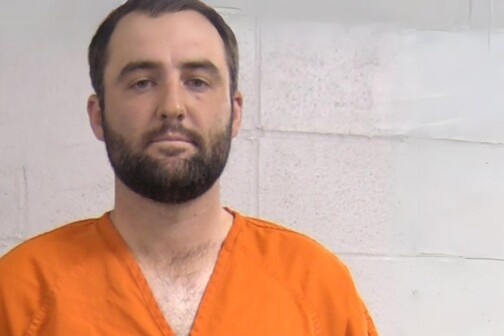Temeckia Derrough lives about three streets from Union Pacific’s rail yard in the historic freedman’s community of Joppa. It’s not unusual, she says, to hear the cars as they’re shunted from track to track. Horns often sound as engines pull in.
“I can still sometimes hear the cars bang together,” she said. “Sometimes, the walls in my house will shake.”
These days, she is watching the events around the derailment and disaster in East Palestine, Ohio, and worrying.
“I watch the news, and I point at the TV and say, ‘That could happen here!’” she said. She knows this because, on July 14, she was one of the first people to arrive at the yard when seven train cars carrying grain derailed.
It would take 11 days before Union Pacific cleaned up the mess. The longer it took, the more the community worried about the next derailment and what the response would look like. What if it was carrying something worse than grain?
There are seven cargo rail operators in Dallas, but the biggest ones are BNSF, Union Pacific, and Kansas City Southern. The federal Bureau of Transportation Statistics says that there are about 1,265 derailments in America each year, on average. U.S. Department of Transportation data show that between 2012 and 2022, there were 65 derailments in Dallas. The rail safety education group Operation Lifesaver found that Texas led the nation in railroad crossing collisions and fatalities in 2021, with 247 collisions and 17 deaths.
The U.S. has more than 140,000 miles of track for freight trains, and all of that track is owned and maintained by private rail companies like Union Pacific. Texas has a total of 10,370 miles of track, and in 2021 had 110.9 million tons of materials leaving the state on those rails and 181.9 million coming in. The bulk was made up of chemicals and petroleum products.
Over the last five years, federal inspectors have found 36 percent more hazardous materials cargo violations involving trains than the five prior years. Fines are up 16 percent. A USA Today analysis of 10 years of rail incidents found that more than 5,000 hazardous materials spills or leaks from trains happened while they were in transit or sitting in rail yards. Last year, companies reported more than 330 spills, and six caused injuries.
All of that, though, is cold comfort when you live next to a rail yard. As a member of the city’s environmental commission, the derailment in Joppa only validated Derrough’s worries that her community was vulnerable to a potential environmental disaster. In September, the commission asked city staff to provide a briefing about its response plan for a potential derailment.
Much of Dallas’ rail lives in heavily populated pockets of town, near highways, the downtown Central Business District, residential neighborhoods, and even near high rises.
Dallas Fire-Rescue Captain Ryan Thornton explained that the track present in Dallas also goes through a lot of water and a lot of wooded areas, including the Trinity Forest. The fire department has specialized teams that respond to hazardous materials situations, he told the commission, and those teams must undergo months of specialized training.
“Unfortunately, this is not an uncommon thing,” he said of derailments. “But we are prepared for it.”
Because the tracks are maintained and operated by rail companies, it’s also hard to know in advance that something dangerous is coming through a neighborhood. After a derailment, authorities can contact the Chemical Transportation Emergency Center (CHEMTREC), which assists first responders in determining what is actually on the payload of any given train and container. Knowing what is in that railcar will determine DFR’s response.
“It’s not something we have a say in, and it’s not something that we can control,” Thornton said. “It is what it is.”
Thornton talked the commissioners through the steps to determine whether a derailment is dangerous to the public, and what happens when that is the case. He also stressed that, for the most part, train cars are specific to the type of substance they carry, and meet rigorous safety standards.
“They’re dropped from the air, they’re crashed,” he said. “They are tested constantly.”
The Bureau of Transportation Statistics said that roughly half of the cars designed to carry flammable liquids, for example, are brand new. Almost all the rest have been retrofitted to meet new federal safety standards.
If the material inside the derailed cars is dangerous, the team will establish hot, warm, and cool zones. Highly-trained members of the team will work in the hot zone, assess the situation, and decontaminate afterward in the warm zone. Everyone else works in the cool zone, which isn’t as much of a threat.
The city’s stormwater management team is also frequently called in to make sure whatever has spilled won’t enter the watershed. If necessary, the 38-member team can direct cleanup and transport the waste from that cleanup to the appropriate site, said Kevin Hurley, the city’s stormwater management superintendent.
Following the city’s presentation, commissioners focused on how to better prepare for a potential derailment. “Can we obtain information that shows when and where hazardous substances are being transported by rail?” Commissioner Barry Lachman asked. City staff said they would look into creating a heat map of areas that are most at risk of a rail-related chemical spill. They said that DFR already monitors some infrastructure related to chemical transport in terms of how vulnerable it is to terrorism.
But both Derrough and Commissioner Renee Robberson felt the city could have intervened more in the days following the Joppa derailment. Derrough wanted to see improved enforcement and oversight from the city. Robberson said she felt the city could’ve put more heat on Union Pacific to clean up faster.
“The city doesn’t seem to have a way to make companies move more quickly,” she said.
On Thursday, Derrough said she didn’t walk away from September’s meeting feeling particularly reassured that her neighborhood wouldn’t someday awaken to the same kind of environmental disaster that she sees on the news from Ohio. Union Pacific, she said, “cleaned all that up” and then never talked to the residents of Joppa again.
“My biggest concern is a derailment,” she said. “It can happen here. This summer proved it can happen.”
Author






